Exploring the Rich History and Natural Beauty of Dambulla
- Gayan Madhuranga
- Nov 3
- 4 min read
Dambulla, a captivating town nestled in the heart of Sri Lanka, is a treasure trove of history, culture, and natural beauty. Known for its stunning cave temples and lush landscapes, Dambulla offers visitors a glimpse into the island's rich heritage. Whether you're a history buff, a nature lover, or simply seeking a serene getaway, Dambulla has something for everyone.
As you embark on this journey through Dambulla, prepare to be enchanted by its ancient wonders and breathtaking scenery.
The Dambulla Cave Temple Complex
One of the most iconic attractions in Dambulla is the Dambulla Cave Temple Complex, a UNESCO World Heritage Site. This remarkable site consists of five caves adorned with intricate murals and over 150 Buddha statues. The history of these caves dates back to the 1st century BC, when they served as a refuge for Buddhist monks.
Visitors can explore the caves, each offering a unique experience. The largest cave, known as the Great Cave, features a colossal reclining Buddha statue that stretches an impressive 14 meters. It takes about 30 minutes to fully appreciate this cave, as the vibrant frescoes that adorn the walls depict various scenes from the life of Buddha. These stunning artworks showcase the artistic skills of ancient Sri Lankan craftsmen and are thought to be over 2,000 years old.
The spiritual ambiance of the caves, combined with the stunning artistry, makes this site a must-visit for anyone traveling to Dambulla.

The Historical Significance of Dambulla
Dambulla's history is deeply intertwined with the evolution of Buddhism in Sri Lanka. The caves were not only a place of worship but also served as a sanctuary during times of conflict. King Walagamba, who ruled in the 1st century BC, is credited with transforming the caves into a significant religious site after seeking refuge there during an invasion.
Over the centuries, the Dambulla Cave Temple Complex has been a focal point for Buddhist pilgrims. Statistics show that this site attracts over 100,000 visitors each year, making it a crucial part of Sri Lankan culture. The complex reflects the resilience of the Buddhist faith and the dedication of those who have maintained it through the ages.
Natural Wonders Surrounding Dambulla
Beyond its historical significance, Dambulla is also blessed with stunning natural beauty. The surrounding landscape is characterized by lush greenery, rolling hills, and vibrant flora. One of the best ways to experience this natural wonder is by hiking to the nearby Sigiriya Rock Fortress, another UNESCO World Heritage Site.
The hike to Sigiriya not only offers breathtaking views of the surrounding countryside but is also a journey through ancient history. As you ascend the rock, which towers 200 meters above the jungle, you'll encounter remnants of an ancient civilization, including frescoes and water gardens that date back to the 5th century AD. In fact, Sigiriya is considered one of the best-preserved examples of ancient urban planning in the world.

Cultural Experiences in Dambulla
Dambulla is a vibrant cultural hub that goes beyond historical sites. The town is filled with local markets, where visitors can immerse themselves in day-to-day life. The Dambulla Market is a lively place, filled with colorful stalls selling fresh produce, spices, and handmade crafts.
Exploring the market is a sensory delight, with the aroma of fresh spices filling the air and the vibrant colors of fruits and vegetables creating a visual feast. Engaging with local vendors is not only enjoyable but also a fantastic way to connect with the culture. For a taste of local life, be sure to try "kottu," a popular dish made of chopped roti mixed with vegetables and spices.
Wildlife and Nature Reserves
For nature enthusiasts, Dambulla serves as a gateway to several wildlife reserves. The nearby Minneriya National Park is famous for its elephant gatherings, especially during the dry season from June to September. It is estimated that over 300 elephants can be seen congregating around Minneriya Tank at this time, creating an unforgettable sight.
A safari in Minneriya offers a chance to witness these majestic creatures in their natural habitat, along with a variety of other wildlife, including leopards, deer, and numerous bird species. The park's diverse ecosystems make it a paradise for nature lovers and photographers alike.
Culinary Delights of Dambulla
No visit to Dambulla would be complete without indulging in the local cuisine. The town boasts a range of dining options, from street food stalls to charming restaurants. Traditional Sri Lankan dishes, such as rice and curry, hoppers, and kottu, should be on your list of must-try items.
Sampling the local flavors is an adventure in itself. The use of aromatic spices and fresh ingredients creates a culinary experience that reflects the island's rich heritage. Popular dishes often include fragrant rice served with an assortment of curries, and don't forget to try a refreshing king coconut drink, which is perfect after a day of exploration.
An Invitation to Explore Dambulla
Dambulla beautifully blends history, culture, and natural beauty. From the awe-inspiring Dambulla Cave Temple Complex to the breathtaking landscapes surrounding Sigiriya, every corner of this town tells a unique story.
Whether you're exploring ancient caves, hiking to majestic rock fortresses, or savoring delicious local cuisine, Dambulla promises an unforgettable experience. As you plan your visit, immerse yourself in the rich tapestry of history and nature that this enchanting town has to offer.
Pack your bags and get ready to explore the wonders of Dambulla – a true gem in the heart of Sri Lanka!



Comments